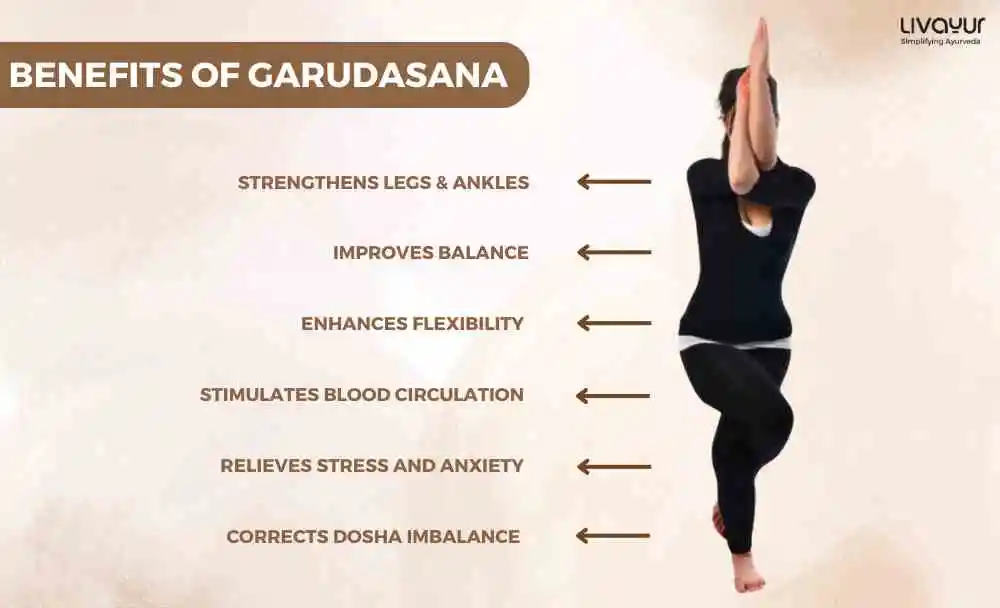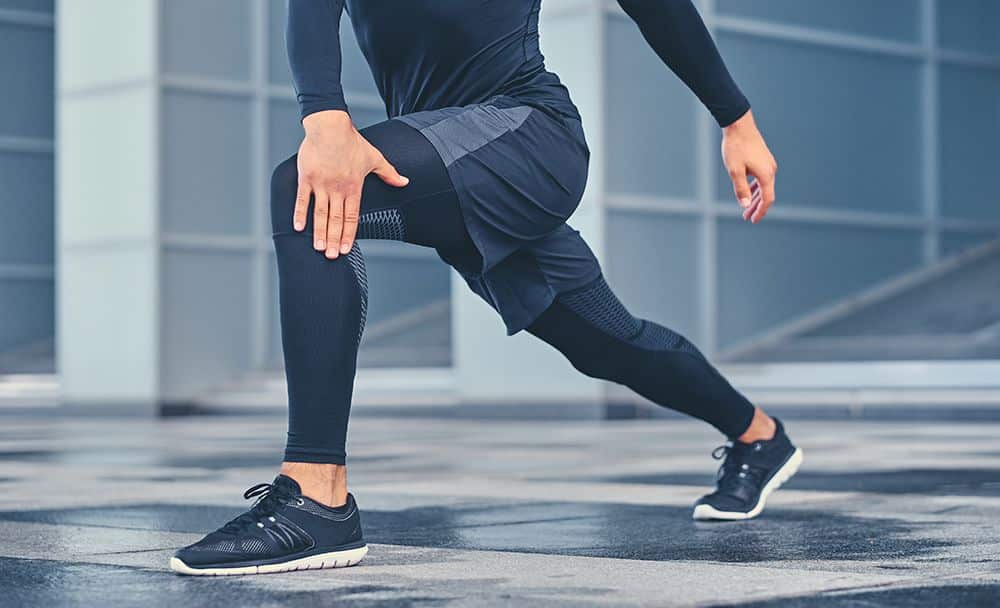
Garudasana or Eagle Pose is a yoga asana that harmonises balance, strength, and flexibility. With roots in the Sanskrit words “garuda” (eagle) and “asana” (pose), this particular posture imitates an eagle soaring through the sky. In this article, we will delve into the extraordinary advantages of Garudasana and present a detailed, step-by-step guide on mastering this pose with precision.
Benefits of Garudasana
Improves Balance and Concentration

Garudasana demands unwavering focus and concentration, making it an exceptional pose for refining balance. Consistent practice of this asana nurtures the ability to remain centred and steady, both on and off the mat. Moreover, it sharpens mental acuity, fostering a state of tranquillity and attentiveness. [1] [2]
Strengthens Legs and Ankles

When performing Garudasana, the standing leg engages various muscles, including the calves, quadriceps, and glutes. By nurturing these muscle groups, this pose fortifies and tones them, cultivating stability and mitigating the risk of leg and ankle injuries.[1]
Enhances Flexibility
The Eagle Pose effectively stretches and opens the shoulders, upper back, and hips. These regions get stretched through the intricate crossing of the arms and legs, enhancing flexibility and releasing accumulated tension. Additionally, it contributes to improved joint mobility, particularly in the shoulders and hips.[1] [3]
Stimulates Blood Circulation
The twisting motion intrinsic to Garudasana stimulates blood and oxygen circulation throughout the entire body. This augmented circulation detoxifies organs and tissues, fostering optimal functionality and overall well-being.[1]
Relieves Stress and Anxiety
The convergence of physical and mental focus in Garudasana enables a serene and tranquil state of mind while effectively reducing stress and anxiety. Activation of the parasympathetic nervous system occurs, promoting deep relaxation and an inner sense of peace. [4] [5]
Corrects Dosha Imbalance
Garudasana can help balance and maintain the Vata Dosha to promote calmness and serenity in the mind. [6]
How to Perform Garudasana
Follow these step-by-step instructions to unlock the full potential of Garudasana:
- Commence in Tadasana (Mountain Pose)
Begin by standing with your feet hip-width apart and arms comfortably relaxed at your sides.
- Shift Weight and Bend Knee
Shift your weight onto your left foot and slightly bend the left knee.
- Cross Thighs
Lift your right foot off the ground and carefully cross your right thigh over your left thigh. If possible, hook your right foot behind your left calf.
- Extend Arms
Extend your arms straight in front of you at shoulder height.
- Cross Arms
Cross your left arm over your right arm, bending both elbows. Bring your palms together, or if that proves challenging, bring the back of your hands into contact.
- Lift Elbows and Lower Shoulders
Gradually lift your elbows while simultaneously lowering your shoulders away from your ears. Maintain focus on a point in front of you to preserve balance.
- Hold the Pose
Maintain the pose for 30 seconds to 1 minute, practising deep and even breathing.
- Release the Pose
To release, slowly unwind your arms and legs, returning to the standing position.
- Alternate Side
Repeat the pose on the opposite side, crossing your left thigh over your right thigh and your left arm over your right arm.
Precautions for Garudasana
Avoid in Case of Injury
If you have recently suffered a knee or ankle injury, it is advisable to avoid practising Garudasana.
Shoulder Injury Modification
Should you have a shoulder injury, modify the pose by keeping your arms parallel to the ground instead of crossing them.
Listen to Your Body
Always listen attentively to your body and modify the pose as necessary to prevent discomfort or pain.
FAQs
Can beginners practise Garudasana?
Yes, beginners can practise Garudasana. However, it is recommended to start with modifications and gradually work towards the full expression of the pose. Seek guidance from a qualified yoga instructor to ensure proper alignment and avoid any potential strain or injury.
What other benefit does Garudasana have according to Ayurveda?
As per Ayurveda, Garudasana can help strengthen and stretch the Mamsa Dhatu(Muscle fibres) in the body. This in the long run will help prevent muscle pulls and nerve pains in your limbs and back.
Is Garudasana suitable for all body types?
Garudasana can be modified to accommodate different body types and levels of flexibility. However, individuals with specific limitations or injuries should consult with a healthcare professional or experienced yoga teacher before attempting the pose.
Can Garudasana help with posture improvement?
Yes, Garudasana can contribute to improving posture. It engages the muscles in the legs, back, and shoulders, which helps promote proper alignment and a more upright posture over time.
How often should I practise Garudasana?
The frequency of practising Garudasana will vary depending on your preferences and goals. Ideally include it as part of your regular yoga practice at least a few times a week to experience its benefits.
Can Garudasana be practised during pregnancy?
Pregnant women should exercise caution when practising Garudasana. It is advisable to consult with a prenatal yoga instructor or healthcare professional to determine if it is safe and suitable for your specific stage of pregnancy.
Conclusion
Garudasana has a multitude of benefits and is relatively easy to master. One should start seeing its benefits in the long run by including the asana in their regular yoga routine. It is however important to take it slow when attempting it for the first time to avoid unwanted injuries.
References:
- An Anatomical Exploration of “Garudasana”(ijtsrd.com)
- View of Study of anatomical effects of Yogasana in Frozen Shoulder | Journal of Ayurveda and Integrated Medical Sciences (jaims.in)
- The effects of a yoga intervention on balance and flexibility in female college students during COVID-19: A randomized controlled trial – PMC (nih.gov)
- Comparative effect of yogasana and pranayama on depression, anxiety and stress levels in adults practitioners(ayush.gov.in)
- The Effect of Yoga on Stress, Anxiety, and Depression in Women – PMC (nih.gov)
- Akshay Satish Patil & Rajendra D. Lambat: Integrated Approach of Ayurved and Yoga in Parkinsonism (Kampavata); A Case Report (iamj.in)

















